Department of Nuclear Engineering
US News and World Report again rated the department number one in its field. The consistency of this ranking over many years has reflected the quality of scholarship by students and faculty in the department.
This past year has been a highly productive one for the Department of Nuclear Engineering in terms of both education and research. On the education front there were a relatively large number of applicants for our graduate program, with a great majority of the admitted students agreeing to join the program. The department, under the leadership of Professor Andrew C. Kadak, initiated a major effort to increase undergraduate enrollment. This included a complete revamping of our undergraduate curriculum and an intensive recruiting program. As a result, we saw a large increase in the number of freshman who selected nuclear engineering as their major (15), which is actually a record for the department.
On the research front there was strong and increased interest as well as funding in all the major areas of the department: fission and energy systems, fusion, and radiation science and technology. A description of some of these very interesting projects is described in the text. Of particular interest is the MIT nuclear reactor. For many years the nation's university research reactors have been under-funded by the DOE making it difficult for them to compete with national laboratory reactors. This past year the US Department of Energy (DOE) recognized the problem and initiated a new peer reviewed competitive program aimed at ameliorating the situation. The MIT proposal prepared by Dr. John Bernard (director of the NRL) in collaboration with NE faculty members, ranked number one in the final review. As a result, the NRL will receive over $1 million per year over the next five years, thereby greatly strengthening its program in terms of instrumentation, scientific support, and greatly increased user friendliness.
Undergraduate Program
Eighteen students were enrolled in the undergraduate program during the past year. This included two sophomores, six juniors, and 10 seniors. Five students completed requirements for the bachelor's degree in nuclear engineering.
Undergraduate curriculum development focuses on strong fundamentals with hands-on experiences in all aspects of nuclear science and engineering applications from energy, accelerators, medicine, research, and policy.
In the spring semester Professor Sidney Yip led a team of nine other faculty colleagues from several departments and HST in developing a new undergraduate subject, Introduction to Modeling and Simulation, for students Institute-wide. This subject will be offered formally next spring as 22.00 with joint listing in six other departments in the Schools of Engineering and Science.
Graduate Program
The graduate program totaled 111 students during the fall term. Of this number, 21 were enrolled for their first term. Thirty-nine percent are specializing in radiation science and technology; 41 percent are working in fission and energy studies, and 20 percent in fusion. The department awarded 14 masters, two nuclear engineers degrees and 11 doctoral degrees during the academic year.
In Professor Kenneth R. Czerwinski's class, 22.76 Nuclear Chemical Engineering, students performed plutonium-uranium separations with reactor irradiated materials. This is the only university class in the US to provide students the opportunity to work with actinides.
Professors Jacquelyn C. Yanch and Yip offered a new subject, Neutron Interactions and Applications, primarily for the students in the radiation science and technology program, but the intention is also to make the contents have wider appeal. A particular emphasis of the subject is the application of Monte Carlo sampling methods to radiation transport.
Faculty Honors, Awards, and Activities
Professor Jeffrey P. Freidberg received the Fusion Power Associates Board of Directors FPA leadership award for 2002. The award is presented annually to those individuals who have shown outstanding leadership qualities in accelerating the development of fusion. He continues to serve as a member of the DOE Fusion Energy Sciences Advisory Committee (FESAC) and served as chairman of the FESAC Burning Plasma Panel.
Professor Neil E. Todreas continues his service to the DOE as a member of the Nuclear Energy Research Advisory Committee (NERAC) and as co-chairman of its subcommittee for the Technology Roadmap for Advanced Generation IV Nuclear Energy Systems. He gave invited presentations on the progress of this roadmapping activity at the 10th International Conference on Nuclear Engineering (ICONE) meeting held in Arlington, Virginia, in April and at the President's Session at the ANS Annual Summer Meeting in Hollywood, Florida, in June. His service continues on the National Nuclear Accrediting Board for operating nuclear reactor training programs.
Professor David G. Cory, Dr. Timothy Havel and their colleagues continue to make advances in the theory, practice and implementation of quantum information processing. In particular they have implemented a solid-state version of an NMR quantum information processor that promises to provide more precise control over larger Hilbert spaces than is available in the liquid state.
Professor Cory (editor in chief) and Dr. Havel (managing editor) have formed a new journal, Quantum Information Processing, published by Kluwer Academic. QIP is an international forum for the publication of peer reviewed papers on all aspects, theory and experimental, of quantum information processing.
Professor Cory received the Ruth and Joel Spira award for distinguished teaching. This award acknowledges the tradition of high quality engineering education at MIT.
Professor Kent F. Hansen received the Graduate School Council teaching award.
Also, the PAI outstanding teaching award (awarded by the student chapter of the American Nuclear Society) was presented to Professor Hansen.
Professor Sow-Hsin Chen received the first career achievement award in nuclear engineering in May 2002.
Professor Czerwinski continued his interactions with Conservatoire National des Arts et Métiers, where he was an invited professor for four weeks. This involved research on actinide-lanthanide separations and teaching at Ecole Nationale Superieur de Chimie de Paris. Professor Czerwinski also made a presentation at CEA Marcoule on the specation of actinide in waste forms. The Marcoule group investigating waste forms is developing a joint research program with Professor Czerwinski.
Professor Czerwinski was a visiting instructor on actinide chemistry for the Department of Energy Radiochemistry summer school at Brookhaven National Laboratory.
Professor Czerwinski was an invited speaker at ACTINIDES 01. His presentation described the use of actinide speciation in environmental remediation. The method is now being used on remediation efforts in Massachusetts and California.
Professor Czerwinski was elected president of the Radiochemistry Research and Education Consortium.
Professor Kazimi gave ten invited lectures during the past year, five of them at international settings. In September he spoke at GLOBAL2001 in Paris on "Back End of the Fuel Cycle, From Research to Solutions." In January 2002 he gave two lectures on emerging directions of nuclear technology at Tsinghua University in Beijing and one lecture at the MIT Annual Japan Industry Forum in Tokyo. In March he spoke on nuclear energy for developing countries at the second meeting of the Arab Science and Technology Foundation (ASTF) held at Sharjah University, United Arab Emirates. He was a member of the steering committee for the International Congress on Advanced Nuclear Power Plants (ICAPP) held in Hollywood Florida in June 2002 at which he also gave an invited lecture on Optimization of the Fuel Cycle. He served as a member of the review committee of the Nuclear and Energy Systems Division of INEEL. At MIT, he served as director of the Center for Advanced Nuclear Energy Systems (CANES), chairman of the MIT Research Reactor Safeguards committee and on the MIT Sea Grant Program advisory board.
Professor Emeritus Elias P. Gyftopoulos was honored by the American Society of Mechanical Engineers for his papers, "Entropy—Part I: Statistics and its Misleading Disorder" and "Entropy—Part II: Thermodynamics and Perfect Order." He received the society's Edward F. Obert award.
Professor George E. Apostolakis was re-elected chairman of the statutory advisory committee on reactor safeguards of the US Nuclear Regulatory Commission effective January 1, 2002. He continues to serve on the International Nuclear Technology Committee that advises the governments of three German states (Baden-Württemburg, Bavaria, and Hesse) on nuclear technology matters. He was re-elected secretary of the International Association for Probabilistic Safety Assessment and Management. He continues to serve as the editor-in-chief of the international journal Reliability Engineering and System Safety. He chaired the Independent Peer Review Panel that reported to senior NASA management on the Probabilistic Risk Assessment of the International Space Station. He was an invited speaker at the fourth National Symposium on Space System Risk Management sponsored by the Aerospace Corporation and the Air Force Space and Missile Systems Center. He was an invited panelist at the workshop on "Performance-Based Regulation: Prospects and Limitations in Health, Safety, and Environmental Protection" sponsored by the John F. Kennedy School of Government of Harvard University.
Professor Ronald M. Latanision was a visiting professor at the University of Naples, Italy. He was appointed a Sauveur lecture, Boston Chapter of TMS International.
Professor Ian H. Hutchinson continues as honorary editor of the journal "Plasma Physics and Controlled Fusion." He presented an invited lecture entitled "Plasma Fusion Research and the Technical and Spiritual Challenges of Sustainable Energy" at the triennial meeting of the International Union for Vacuum Science, Technique, and Applications (IUVSTA) hosted by the American Vacuum Society in November 2002.
Professor Jeffrey A. Coderre was awarded the Norman C. Rasmussen career development chair by the Department of Nuclear Engineering.
Professor Linn W. Hobbs, who was given a joint appointment in the Department of Nuclear Engineering this year, was made an officer of the Order of the British Empire (OBE) by Queen Elizabeth for his contribution to British-American educational programs through his long service with the Marshall Scholarship program. Professor Hobbs was appointed a member of the National Research Council (National Academy of Sciences) committee on improving the scientific basis for managing nuclear materials and spent nuclear fuel. An earlier NAS/NRC committee, on which he served, the committee on long-term research needs for radioactive high-level wastes at DOE sites, published its findings in July 2001. Professor Hobbs was also appointed to an ongoing DOE independent review panel to evaluate the Radioactive Isolation Consortium, LLC, advanced vitrification system.
At MIT, Professor Hobbs won the Institute's 2002 Arthur C. Smith award for his sustained contributions to undergraduate education and student life.
Research
Fission
The Center for Advanced Nuclear Energy Systems has expanded its research programs with the awarding of several projects to the center faculty. Two new DOE grants from the Nuclear Energy Research Innovation (NERI) program were initiated this year. This brings the total number of NERI projects involving MIT to 14 out of 69 winning projects (more than 600 applications were submitted to the NERI program) over the three cycles to date. Professor Kazimi and Dr. Pavel Hejzlar received with industrial partners a three year, $2.4 million NERI grant for the development of internally cooled annular fuel for pressurized water reactors (PWR). The project involves design and manufacturing optimization of such fuel as well as testing some of the design characteristics in the MIT reactor. If successful such fuel will allow significantly higher power densities in the PWR core (up to 50 percent) with safety margins that are equivalent or enhanced relative to today's reactors (Figures 1 and 2). The other NERI project involved Professor Latanision who is working with INEEL to study the corrosion of structures in water at temperatures about 550 C and pressures of 35 MPa, representative of those in a thermodynamically supercritical water reactor.
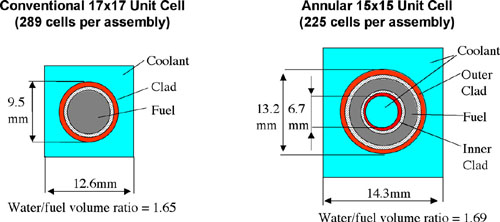 Internally and externally cooled advanced PWR fuel |
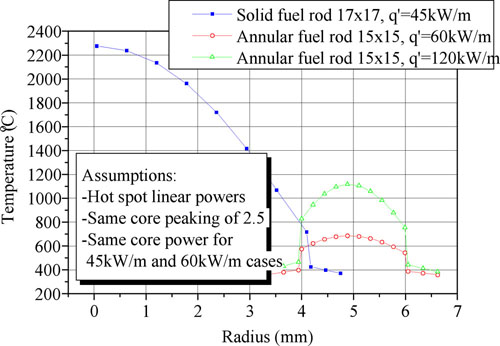 Reduced temperature in annular fuel rods |
Two projects on the design of gas cooled fast reactors were initiated under Professor Emeritus Michael Driscoll. One involving the optimization of the plant design to provide wide safety margins making use of added thermal capacity in the core through an appropriate core matrix. The other involving the design of a direct cycle thermal conversion system using supercritical COc as the working coolant. This brings the number of reactor system concepts being investigated at CANES to four—the integral system LWR with long fuel cycle core, the modular, helium cooled pebble bed reactor, the lead-bismuth cooled fast reactor and the supercritical CO2 gas turbine reactor. The four concepts are supported by INEEL through a cooperative agreement using laboratory directed funds, and through a number of NERI projects.
Several other programs involving advanced fuels and fuel cycles were initiated. Professor Ronald G. Ballinger initiated a project supported by the Electric Power Research Institute to investigate the effects of noble metals on corrosion of the cladding in boiling water reactors. He was also the recipient of an International NERI award to investigate the migration of fission products in particle fuel coatings. Professor Kazimi and Dr. Hejzlar started a project for investigating the feasibility of transmutation of plutonium and minor actinides in light water reactors using neutronically inert materials to host the actinide fuel. Application of lead-cooled reactors for transmutation of actinides in inert fuel hosts were the subject of a new project by Professor Todreas and Dr. Hejzlar. Professors Kazimi and Czerwinski initiated a DOE Cooperative Research and Development Agreement (CRADA) for cleanup of uranium metal scraps. That CRADA involves Global Nuclear Fuel, Brookhaven National Laboratory and the Uzbekestan Center for Nuclear Fuels at Ulba. Professors Kazimi and Driscoll continue to investigate the feasibility and economics of very high burnup uranium and thorium fuel cycles in PWRs.
Professor Todreas continues as principal investigator for the following two-advanced nuclear reactor conceptual design projects. The first is a low power rating modular light water reactor being developed by an international consortium of industry, laboratory, utility, and universities led by Westinghouse and sponsored by the US DOE's Nuclear Energy Research Initiative Program. The second is a large power rating lead-bismuth eutectic cooled fast spectrum reactor aimed at both low electricity production cost and actinide destruction being designed in collaboration and with the sponsorship of the Idaho National Engineering and Environmental Laboratory (INEEL).
Professor Latanision's collaborative research with faculty at the Pennsylvania State University has reached the point of producing reference and pH electrodes that function in high temperature-high pressure water. These electrodes will allow us to examine our prediction that control of dealloying and stress corrosion cracking of the Hastelloy C-276 materials of construction of supercritical waters oxidation systems can be achieved with appropriate thermodynamic control of the operating protocol. Tests are underway.
Advanced Reactor Research: Modular Pebble Bed Reactor
What started as an IAP project in 1998 has been transformed into a major design project to develop an advanced reactor that can meet the public's expectations for safety and the industry's expectations for competitiveness. As evidence of global climate change mounts, the importance of nuclear energy as an element in the world's energy mix is becoming apparent. The Department of Nuclear Engineering is in the forefront of advanced reactor development with the modular pebble bed reactor (MPBR) as one of the earliest technologies that could be deployed.
With support from the INEEL and competitively awarded DOE's Nuclear Energy Research Initiative (NERI) grants, the pebble bed project team has focused on the conceptual design of the complete power plant. The major effort is aimed at identifying the significant technical issues that need to be addressed to bring this technology forward. The current research and development initiatives include developing a new state-of-the-art fuel performance model with irradiation testing of new fuels; safety analysis including air ingress which includes a collaboration with the Jülich Research Center in Germany in their upcoming experiments at the NACOK facility; development of a balance-of-plant design that uses a dramatically different approach to the power conversion unit by employing an indirect cycle with an intermediate helium-to-helium heat exchanger; core physics analysis using advanced Monte Carlo techniques. This capability is presently being expanded by the installation of a Beowulf cluster of 30 PCs that will permit performing Monte Carlo core physics calculations including depletion and incorporating online refueling capabilities.
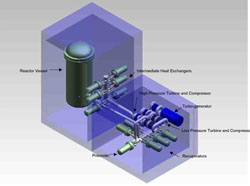 Current modular layout with space frame insert of pebble bed reactor |
One of the major new innovations being developed is to radically change how nuclear power plants are built. Instead of building larger and larger plants, the modular pebble bed reactor is small, only 120 megawatts electric (about one tenth the size of current generation plants). This size allows for quicker construction and easier financing. The design is aimed at high modularity allowing for factory fabrication and site assembly using a "lego" type approach. Shown here is an example of the modular design in which the entire balance of plant can be shipped to the site in 21 trucks carrying space frame components that are simply bolted in place. The target is to build the plant in about two years that could make the plant competitive with natural gas power plants.
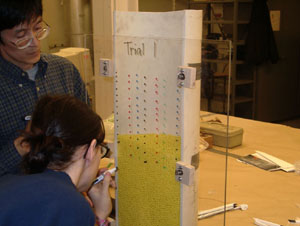 Students tracking pebble flow in the 1/10 scale mock up of the pebble bed reactor core |
Any new nuclear plants will require a design that does not increase proliferation risks. The project team has also performed scoping work on non-proliferation and safeguards. Preliminary studies have also been completed on nuclear waste disposal. The senior design class has also developed a conceptual design of a power distribution monitoring system for the pebble bed reactor using tomographic imaging techniques. Recently completed was a class-designed experiment on pebble flow and mixing in the reactor core. The photo at left shows some members of the class in the laboratory with their experimental assembly that they used to confirm the laminar pebble bed flow in conjunction with the Department of Mathematics.
In the future, proposals have been submitted which include collaborations with several industrial firms to design and develop an advanced instrumentation and control system that could have generic applications that would allow for "hands-free" start-up of the reactor in a modern control room environment. A proposal has also been submitted on a computational fluid dynamics analysis of helium flow in a pebble bed reactor under normal and accident conditions that will be experimentally benchmarked. This flow methodology will be used to better understand temperatures in pebble bed reactors. As part of the safety research, a proposal has also been submitted to test the oxidation rate of graphite used in fuel and reflectors for high temperature gas reactors and to develop advanced coatings to eliminate or reduce the consequences of air ingress. This work has been proposed in collaboration with MIT's Plasma Science and Fusion Center, Battelle Pacific Northwest Laboratories and Jülich Research Center. The MIT Research Reactor will also be used to perform a series of graphite irradiation tests that are important in the safety and economics of high temperature gas reactors.
One of the unique applications of high temperature gas reactors is in the production of hydrogen and other process heat applications. This new area of development will attempt to link the nuclear plant to a hydrogen production facility in a safe manner. The interesting aspect is to identify what design features would be necessary from the standpoint of the safety implications of such collocation and whether such a combination is practical from the regulatory standpoint. For more information please contact Professors Kadak or Ronald G. Ballinger.
Professor Czerwinski continued investigating the speciation of neptunium in spent nuclear fuel with Argonne National laboratory on a DOE-NERI supported project. The project is yielding results on the expected repository behavior of neptunium.
Speciation of actinide containing waste forms have been performed for the United States Air Force. The results were used in remediation of contaminated sites and have lead to the development of a method for incorporating actinide speciation into environmental remediation.
A joint project with Ecole Nationale Superieur de Chimie de Paris (ENSCP), Conservatoire National des Arts et Métiers, Paris, and Los Alamos National Laboratory investigates lanthanide and actinide separations. Templated ion specific resins for uranium, thorium, neptunium, and americium have been synthesized. The project is supported by the Presidential Early Career Awards for Scientists and Engineers (PECASE) award.
Through a University Research Collaboration (URC) project on Th fuel headed by Professor Kazimi, investigations on the behavior of Th fuel in a repository are continuing. Recent efforts for the first time examined the effect of gamma radiation on spent fuel speciation.
Radiation Science and Technology
Neutron capture therapy for cancer research, directed by Professor Otto K. Harling, continued for the 15th year with strong support from federal agencies. In the last year, significant progress was made in the development of this cellular tumor targeting therapy. The new fission converter based epithermal neutron irradiation facility (FCB) at the MIT research reactor was fully characterized and otherwise readied for clinical studies. The dosimetric characterizations verified that the beam from this facility combines the highest intensity of any such facility in the world with near optimum beam purity. During the year all necessary approvals were finalized for the initiation of clinical trials. These trials will be carried out under the medical direction of Dr. Paul M. Busse from the Harvard Medical School affiliated Beth Israel Deaconess Medical Center. Two separate clinical trials are now open for subject accrual. One trial is for intracranial gliobastoma multiforme and metastatic melanoma, and the second trial is for metastatic melanoma on the peripheries. Both trials are funded and approved by the National Cancer Institute. The US Department of Energy provides funding for the staff and infrastructure needed to support these clinical trials and other neutron capture therapy research centered at the MIT reactor.
The US Department of Energy is also supporting Professor Harling's group in the upgrading of a second neutron beam at the MIT reactor. This beam is a high intensity thermal neutron beam to be used for small animal irradiations and clinical studies of skin cancer therapy.
The MIT/Harvard program in neutron capture therapy is the leading research program in this field in the US and is acknowledged as one of the leading programs in the world.
Research in Professor Coderre's laboratory continues in two main areas: boron neutron capture therapy (BNCT) and the basic radiation biology of alpha particles. The BNCT project focuses on measuring the sensitivity of the normal lung to the high linear energy transfer radiations produced during BNCT. This project will also investigate the mechanisms by which radiation causes damage in the lung and will explore possible biochemical approaches to reduce these side effects. The methodology has been established to measure breathing rates in rats following whole lung irradiation. A Phillips RT 250 Orthovoltage x-ray machine, donated to the Department of Nuclear Engineering, has been installed and calibrated and will be used as the control radiation for all radiobiology experiments.
Americium-241 foils have been purchased and fabricated into alpha particle irradiation sources for cell culture experiments. These sources span five orders of magnitude in intensity and will provide a resource for development of a tumor micrometastasis model that allows the quantitative analysis of the effects of localized deposition of alpha particle radiation. This system will model radioimmunotherapy, where alpha-emitting nuclides attached to monoclonal antibodies are delivered non-uniformly to the surface of a tumor metastatic site, and will allow systematic studies on ways to improve prostate tumor therapy.
Professor Coderre has established a research collaboration with Professor Peter Dedon, of the Biological Engineering Division, to look at the effects of alpha particle radiation on DNA in solution. Professor Coderre was awarded a pilot study grant by the Center for Environmental Health Studies in the Biological Engineering Division to study a phenomenon known as the "bystander effect" where cells not directly hit by radiation, nevertheless, show damage. This effect has implications for assessment of the risk associated with exposure of the lung to radon alpha particles.
Quantum Information Processing (QIP)
Professor Cory and his students continue to explore NMR approaches to quantum information processing through a set of collaborations with Dr. Havel (NED), Professor Seth Lloyd (ME), Professor Eddie Farhi (Physics), Dr. Raymond Laflamme (University of Waterloo), Dr. E. Knill (LANL), Dr. J. Yepez (AFRL). We have developed new means of coherent control (in the presence of decoherence and incoherent interactions) that achieve experimental fidelities of 0.99.
We have constructed a new scheme for extending the success of NMR approaches to QIP to larger systems via a solid-state device capable of coherently controlling 10–30 qubits. We are using this scheme to explore quantum complexity and the transition from quantum to classical dynamics.
We have investigated quantum chaos with the aims to develop experimental signatures which differentiate regular from chaotic dynamics, and to show the connection of chaotic couplings to an environment with decoherence.
We have defined and experimentally implemented a new model of quantum decoherence that requires a minimum number of quantum resources. This system is coupled to a simulated quantum environment that is periodically and randomly re-dressed to introduce user defined decoherence.
NMR of heterogeneous semi-solids
In collaboration with Dr. S. Singer, and Dr. Pabitra Sen of Schlumberger Doll Research Laboratory we have continued to explore the structure and fluid dynamics of complex media. The heterogeneity of the sample itself sets up a signature of the local geometry that provides a simple and direct means of characterizing micron scale structures. Knowledge of this provides insight into cellular differentiation and fluid transport through complex structures.
NMR imaging of neuron structure and function
Dr. Alan Jasanoff (a Whitehead fellow at MIT) has developed the tools to enable the neuron structure and response of blowflies to be explored at high resolution via NMR microscopy. The use of blowflies provides a stable and well-characterized test bed, while simultaneously permitting near cellular resolution in the NMR. This in turn enables the observation of neuron activity in living/functioning tissue with the markers being directly traceable to neuron biochemistry. Dr. Jasanoff is developing a series of exodenous markers of biochemical response for neuro-science.
Professor Yip is actively continuing his research in the area of materials modeling, and lecturing during the past year at international meetings in Italy, France, and the UK. He is serving as a core editor on an encyclopedia project on materials modeling, the long-term objective being to establish computational materials as a field analogous to computational physics and computational chemistry.
Professor Chen and his graduate student Wei-Ren Chen has made a discovery of a new phenomena of a glass-to glass transition in a colloidal system with very short-range attractive interaction, using neutron scattering technique. This type of inter-particle interaction is unique to colloidal systems due to their large dimensions (~ 100 Å) and cannot be realized in atomic or molecular systems. Collorary to this phenomenon is the existence of the end point of this transition line, called A3 singularity point, where the two types of glass states become identical. Their neutron scattering experiment also verifies the existence of this end point. Their finding will appear in a paper in August 1 issue of the Physical Review E. Because of this discovery, Professor Chen was invited to give a lecture in a summer school on spectroscopic investigation of collective excitations in condensed matter, which took place in the International Center for Theoretical Physics, Trieste, Italy in June 2002.
The events of September 11 have led to an increased interest in Dr. Richard C. Lanza's work on explosive and contraband detection. This resulted in a significant amount of publicity on this work including newspaper and TV interviews, both locally (WGBH) and nationally (the Today Show). Currently, there is a major effort to expand this technology into other areas of concern.
Medical Imaging
The work on coded aperture imaging for simultaneous high sensitivity and high resolution of radioisotopes has been expanded to concentrate on small animal imaging (with Ralph Weissleder, Center for Molecular Imaging Research at MGH), for cancer (John Frangioni, Beth Israel) and brain studies (CMIR) as well as application to pediatric imaging (Roberto Accorsi, Children's Hospital of Philadelphia). New mask fabrication techniques have reduced the cost and improved the performance; current limits appear to be around 700mm. The range of energies accessible has increased to 511 keV; which includes the use of PET isotopes such as 18F. Extension of the technique to full three-dimensional imaging ("SPECT") appears possible based on work with collaborators (John Idoine, Kenyon College and University of Aberdeen).
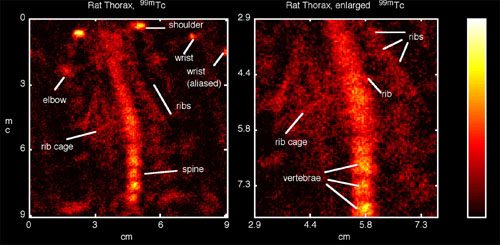 In vivo imaging of a juvenile rat whose skeleton has absorbed a bone-seeking radiopharmaceutical |
An example of high-resolution imaging not possible without this technique is the in vivo imaging of a juvenile rat whose skeleton has absorbed a bone seeking radiopharmaceutical. As part of an effort to understand the nature of addiction in small animal models, the Office of National Drug Control Policy has funded a three year extension of coded aperture imaging specifically aimed at improving brain SPECT imaging. As part of this, two complete SPECT imaging cameras have been installed for use with the coded aperture system.
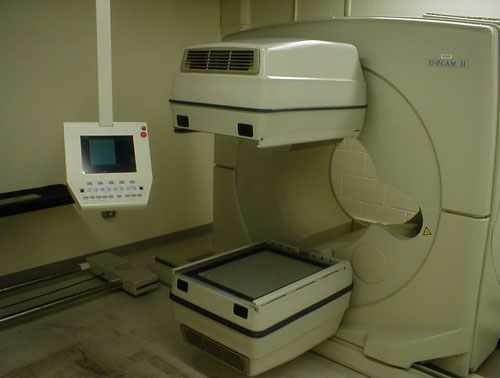 SPECT imaging camera with the coded aperture system |
Contraband Detection
This work is continuing including both neutron resonance radiography and prompt neutron activation methods. A passive imaging system is under design for use in the detection of illicitly transported fissile materials and nuclear devices.
Intense Neutron Sources
This program is a collaboration of work between MIT and the Lawrence Livermore National Laboratory for the development of intense, bright neutron sources, primarily for use in high-resolution fast neutron radiography. We have made progress in the development of windowless targets for this application. Fast neutron radiography is a potential method for non-destructive examination of large dense structures; which are not accessible to other techniques.
Neutron Phase Contrast Imaging
In collaboration with researchers at NIST we are designing and constructing an imaging system, which uses the wave properties of thermal neutrons to produce phase shift contrast images. This approach greatly enhances the contrast of small defects and features; initial estimates are that this technique may be as much as a factor of 1,000 times more sensitive than conventional radiography. A small test facility is being installed in a test beam at the MIT reactor.
Radiation Damage and Nuclear Waste
Professor Hobbs shifted his effort studying radiation-induced amorphization in silica and silicate solids to amorphization of silicon carbide, a compound likely to appear in near-first wall structural applications in fusion reactors. He and Dr. Xianglong Yuan (post-doctoral assistant) have shown using molecular dynamic topological modeling that the surprisingly facile amorphization of SiC is driven by chemical disorder, which they show induces an actual reversible glass transition above a chemical disorder threshold. The finding has implications for predicting swelling of irradiated SiC, which derives largely from induced chemical disorder before the amorphization threshold is reached. Professor Hobbs and Dr. Yuan have also applied their topological methods, collaboratively with researchers at Pacific Northwest National Laboratory, to the definitive identification of point defect configurations in rapidly amorphizing SiC, in which a crystalline reference lattice has been effectively lost.
Professors Hobbs and Yip are participating, together with counterparts from the University of Cambridge, in a new Cambridge-MIT Institute (CMI) program on nuclear waste encapsulation in ceramic media. The aim of the three-year program, which also involves substantial support from British Nuclear Fuels Ltd., is to significantly improve design and radiation resistance of crystalline ceramic nuclear waste media for high-level nuclear waste and actinide storage through studies using modeling and experiment.
Fusion
High power plasma propulsion and high energy density laser-matter interaction
Professor Kim Molvig and Dr. Oleg Batishchev continued study of Variable Specific Impulse Magnetoplasma Rocket (VASIMR) experiment, which is being developed at the Advanced Space Propulsion Laboratory at NASA Johnson Space Center. The results for the optimized helicon plasma source operation were presented at several key meetings and incorporated into ongoing experiment. During his invited visit to the Universidad Nacional Autónoma de México (Mexico City, Mexico) in April 2002. Dr. Batishchev gave VASIMR project review lecture at the Instituto de Ciencias Nucleares.
Professor Molvig and Dr. Batishchev were invited to University of Michigan's Center for Ultrafast Optical Science in December 2001, where they have presented a talk "Advanced kinetic modeling of future CUOS/FOCUS experiments." A number of joint projects on high energy density laser-matter interactions have been initiated.
Dr. Batishchev was invited to visit the University of Alberta (Edmonton, Canada) in May 2002, where he presented a talk on kinetic simulation of non-local and thermal effects in laser heated plasma. He also gave an invited lecture at the mini-course on computational modeling of plasma ( http://laser.phys.ualberta.ca/~rsydora/Icops-minicourse.html/) entitled "Fokker-Planck and Vlasov-Particle-in-Cell Hybrid Methods" as a part of the ICOPS'02 meeting (Banff, Canada).
The Alcator C-Mod Experiment
The Alcator C-Mod tokamak is a major international fusion experimental facility, directed by Professor Hutchinson. Research continued in high-performance, compact magnetic plasma confinement. The upgrade to permit quasi-steady-state exploration of Advanced Tokamak operation with high fractions of self-generated current is nearing completion, under the leadership of Professor Ronald Parker. The 4.6GHz high-power RF sources are now installed and the wave launcher, being fabricated by collaborators, is due for installation in March 2003.
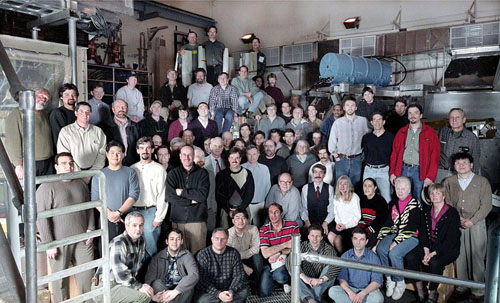 Staff of the Alcator C-Mod Experiment, a major international fusion experimental facility, gathered in the Experimental Cell during a recent reassembly. |
C-Mod is recognized as one of three major US national fusion facilities. The team includes approximately 16 MIT staff scientists, 18 MIT graduate students, 18 engineers, and 25 technicians. In addition we have collaborators from around the world, bringing the total number of scientific users of the facility to about 120.
Facility operation this year has been limited, in part, by a scheduled deassembly for inspection of the magnet and upgrade of the divertor and other structures for higher current operation and improved diagnosis of the plasma. This engineering work was successfully completed. However, the more fundamental limitation to operation has been funding. Recognizing this problem, the Office of Fusion Energy Sciences of the US Department of Energy put forward a plan for substantial increases in funding for fiscal year 2003. The presidential budget proposed an increase of approximately $4 million for the facility, to enable a major increase in operations time, moving towards full utilization. Congress has not yet passed this proposal, but we are anticipating that it will be passed.
Highlights of recent research achievements include the following:
We have shown that the particle transport in the core of the plasma is reduced by putting the main source of heating about half way out from the center of the plasma. In C-Mod this heating is the absorption of radio frequency waves through resonance with the cyclotron motion of the ions about the magnetic field. This process is naturally quite localized at a position where the frequency is equal to the ion cyclotron frequency. By changing the magnetic field, the resonance position can be moved. We find that with off-axis heating, the particle density peaks up slowly in the center of the plasma, consistent with a reduction of diffusivity, and the consequent effects of the known trapped particle pinch. More exciting still, we have shown that by applying heating at a second frequency, chosen to heat the plasma center, we can control the peaking of the density profile, and produce a stationary peaked profile. This result shows that the density profile can be actively controlled—a long-standing objective of transport research in tokamaks.
A new turbulence imaging diagnostic has revealed new features of transport near the edge of the plasma. The plasma is imaged using a fast camera with exposure times as short as a few microseconds. Short wavelength density perturbations are observed that show persistent blobs moving in time. This phenomenon, referred to generally as "intermittency," is characteristic of the edge turbulence, and provides important evidence for its underlying causes.
In related research, the plasma turbulent transport outside the confined regions has been seen to be dominated by the intermittent transport phenomenon, and to be much more important than previously thought. Our experiments have shown that the blobs are capable of transporting much more plasma across to the solid surfaces of the main chamber than had been realized. This observation is important because it will affect the design of future experiments and their plasma-facing components.
Short-wavelength waves have been directly observed arising from mode-conversion of the RF-heating power. Full-wave modeling, using state-of-the-art parallel computer programs, has shown that these wave phenomena are rather more complicated than had become widely thought, and include coupling to more than one type of electrostatic wave. The modeling is therefore correcting our understanding of the mode-conversion process, and the experiments are verifying the models.
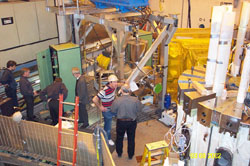 The Alcator C-Mod Tokamak's new neutral beam injector for diagnostics |
A new neutral beam injector for diagnostics was installed. This beam was designed and fabricated by the Budker Institute in Siberia, and is part of a collaboration with the University of Padua.
The process leading to renewal of the Alcator research grant (due at the end of 2003) began with a US Tokamak workshop, held in May 2002, where the research plans were presented and discussed.
Graduate student Antonio Bruno, Professor Freidberg, and PSFC visiting scientist Dr. Jim Hastie completed the development of a new theory to predict the anomalous heat transport observed in ohmically heated reversed field pinches. The basic idea is to calculate the steady state temperature and magnetic field profiles assuming the plasma relaxes to a driven state of minimum energy that is marginally stable to all ideal and resistive MHD instabilities. The results agree remarkably well with existing experimental data and Antonio was selected to present an invited talk on this work at the annual Sherwood Fusion Theory Conference at the University of Rochester.
Student Awards and Activities
Extracurricular NED student functions centered on the MIT American Nuclear Society student branch. There were many social and athletic events during the year reflecting the interests of its members. The every other Monday afternoon seminar series, NED orientation for incoming students, the holiday party, and the international dinner are a few of the successful events from the past year.
Ian Parrish received the School of Engineering's Henry Ford II award. The award is given to a senior engineering student who has maintained a cumulative average of 5.0 at the end of his/her seventh term and who has exceptional potential for leadership in the profession of engineering and in society.
Also, the Xi chapter of Phi Beta Kappa voted Ian Parrish to accept membership in the society in recognition of his excellent academic record and commitment to the objectives of a liberal education.
The MIT chapter of the Alpha Nu Sigma society, a national honor society for students in applied nuclear science and nuclear engineering, recognized six graduate students and two undergraduate students for their outstanding academic achievement. The MIT Health Physics Society student branch's activities are focused on environmental radiation transport, radiobiology, and radiation detection and measurement.
A number of students were recognized at the annual international dinner/awards ceremony in May 2002.
Li Liu (fall) and Jacopo Saccheri (spring) received the Manson Benedict fellowship awarded to a graduate student for excellence in academic performance and professional promise in nuclear engineering.
Victoria Anderson received the Roy Axford award for academic achievement by a senior in nuclear engineering.
Tanya Burka received the Irving Kaplan award for academic achievement by a junior in nuclear engineering.
Graduate students Virginia Curran and Juliet (Leigh) Outten shared the Outstanding Student Service award in recognition of exceptional services to the students, the department and the entire MIT community.
Graduate students Paola Cappellaro and Bilge Yildiz shared the Outstanding Teaching Assistant award in recognition of exceptional services to education by a teaching assistant.
Selected by the American Nuclear Society's Education and Training Division to receive a 2002 ANS graduate scholarship award were Virginia Curran, Scott Kiff, Karen Noyes, Leigh Outten, and Jacopo Saccheri.
More information about the Department of Nuclear Engineering can be found on the web at http://web.mit.edu/ned/www/.